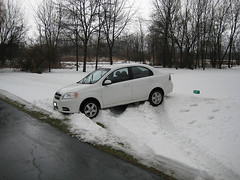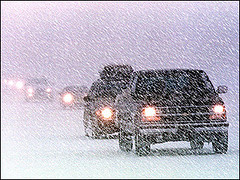Now that winter has well and truly arrived – Monday’s rain notwithstanding – we need to remind ourselves, once again, that we need to adjust our driving habits.
As well, there are certain practices we need to embrace during the winter driving season that will make it safer for us – and others.
Sweep your vehicle off!

Running the windshield wipers or swiping a clear spot on the windshield in front of the driver’s position is simply not good enough.
Driving involves being aware of our surroundings, including other vehicles, pedestrians, and various other hazards. If side and rear windows are covered with snow, and if your view through the windshield is just a hand-cleared “port hole,” there is no way you can adequately see anything other than what might be directly ahead of you.
I know a lot of drivers who say, “It’ll blow off as I drive away.”
Well, maybe. If it does, it will likely blow off your vehicle and create a mini snowstorm for any drivers following you.
Of perhaps it will fly off in chunks, landing on someone else’s windshield.
Then again, I have seen vehicles that have a foot of snow on the roof and trunk lid days after the last snowfall. You can see that some of the snow has indeed blown off, but most is still just sitting there.
The worst, of course, are the ones who don’t brush off the hood, and are left to crane their necks to peer over the pile of snow blocking their view.
Not only is clearing your vehicle of all snow a safe practice, it is required by law.
Also, head out and start your car and start sweeping it off a few minutes earlier than you would normally leave. This will allow the heater to clear the frost from inside your windshield.
Put the phone down!
Next, and this cannot be said enough, is to hang up and drive.
I’ve discussed this many times, and while the police are ticketing drivers for using cell phones while driving, the message still has not reached every driver.
There are far too many drivers who, I can only assume, must believe that they possess far superior driving skills than the average mortal, and continue to drive with a phone stuck to the side of their heads.
If its dangerous when the roads are bare, isn’t it more dangerous in the winter, with snow-covered and icy roads lined with snow banks?
Slow down!

One of the “other” sites posted a story the other day, telling of a driver who lost control rounding the curve onto Bay Street from Huron Street. The driver ended up climbing the curb and striking a tree in the Casino parking lot.
The story explained that “slushy road conditions” were a factor in the collision.
Indeed, I have no doubt that the slushy conditions were a factor. What likely was a bigger factor, however, was the driver’s speed.
Other drivers had successfully negotiated that same curve, without losing control of their vehicles.
As a driving instructor, I like taking my students out on days when the roads are slushy or snow covered, so that they can experience these road conditions with an experienced instructor guiding them safely through these hazards.
Often I will take them to an un-plowed parking lot where they can experience understeer without the risk of approaching or oncoming traffic.
They learn, usually quite quickly, that reduced speed equals increased traction.
Speaking of speed… I have been saying this for years, too: If you own a four-wheel drive vehicle, SLOW DOWN!
Yes, four-wheel (or all-wheel) drive does provide increased traction on snow-covered roads, especially when starting off, but it doesn’t stop any faster.
Snow tires work!

I’ve mentioned this before, as well.
Snow tires – aka: Winter tires – are designed for (believe it or not) driving in the winter.
Not only do they have a more aggressive tread, one that clears itself of accumulated snow, but the rubber compound is designed to be more flexible in colder temperatures, giving it better grip.
“Mud-and-Snow” (M+S) and “All Season” tires have their uses, and for three seasons are excellent tires. However, they are not designed for the kind of winter conditions we have here.
Yes, I know people who swear by their All Season tires, and can claim they have never been stuck nor been involved in an “accident.”
However, if they were to try snow tires they would be astonished at the very noticeable difference in the handling of their vehicle.
I, too, went the All Season route at one time. And I, too, was astonished at the improved handling afforded by snow tires.
Allow yourself more time!
This isn’t just about slowing down – although that is part of it.
Allowing yourself more time also takes into account that traffic may be moving slower than usual due to road conditions, or because there may be snow plows further ahead.
It also allows for icy intersections where vehicles may not start-off as quickly as usual, and you may end up sitting through a second – or even third – red light at some intersections.
Recognize that what might typically be a ten or fifteen minute drive could be twice that long in the winter, and either adjust your departure time accordingly (in the morning) or be prepared to arrive a bit later (at the end of the day).
The brake is not always your friend.
This is a bit of advice given to me by the Instructor-Trainer I studied under when I became a Driving Instructor, and it is advice I pass on to all my students.
Most of the time this applies when someone is backing or pulling out of a driveway without looking, and is likely going to pull into my path. If I were to brake in such a situation, I could end up stopping just in time to be hit by that vehicle.
Instead, I should accelerate, and swerve if safe to do so, to get clear of that hazard.
In the winter, braking can cause all four wheels to lock-up, rendering any attempt to steer futile.
(Again, snow tires are a tremendous advantage!)
Watch this video, and note how many drivers simply stand on the brakes and slide... with predictable results.
Turn on your lights!

Most newer vehicles have "Daytime Running Lights." DRL systems activate the headlights, often at lesser brightness, as soon as the engine is started and the parking brake released. (You do use your parking brake, don't you?) Some systems activate a steady amber light (basically your turn signals), instead.
Neither of these are as bright as headlights, nor do they turn on your tail lights.
Now, you may say that tail lights are not needed during the day, and you'd be mostly correct. But on cloudy days, especially in the snow or rain, your tail lights make your vehicle more visible to other drivers.
As well, far too many drivers do not realize that they do not have their lights on when it is dark, because the DRL causes a splash of light on the roadway in front of them. Unfortunately, the DRLs are not as bright as headlights nor, as already mentioned, are the tail lights activated.
(Of course, if they were to look down at their spedometer they would know their lights are not on, because DRLs do not turn on the dash lights, either.)
The result is a vehicle that is nearly invisible from behind.
Next time you are on the road -- especially in the day time -- take note of vehicles that have their headlights on, and those that don't. See which you can spot sooner.
Be alert, and be patient.

Even if you sweep your vehicle off, leave early, and drive with increased caution, there will be those on the road who don’t. Other drivers may be running late and in a hurry.
Be prepared for them, and be patient. If you get cut-off by a driver who couldn’t see you through the frost and snow obscuring his or her vision, it won’t be helpful to anyone to over-react.
Be alert, and watch for these drivers. If you see a “moving snow bank” don’t be surprised if it suddenly changes lanes or pulls out in front of you.
We need to share the roads, even with the less-cautious drivers.
The only way to ensure your safety is to stay alert, and drive defensively.
If only all drivers would do so, driving would be a far less risky proposition, winter or summer.
But… that’s just my opinion.